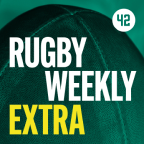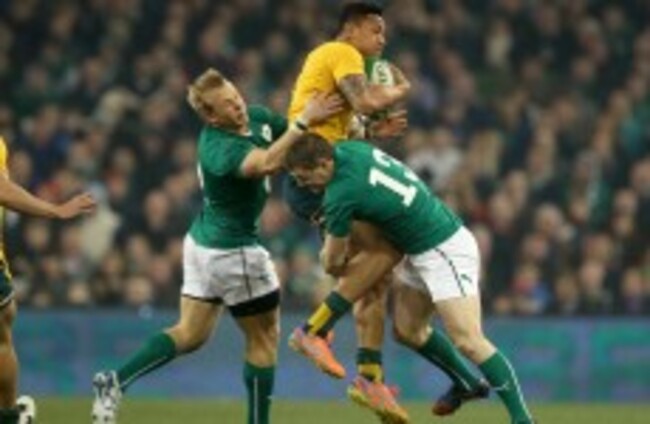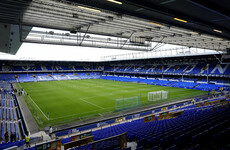IT’S TAKEN US a few days to bring ourselves to re-watch Ireland’s 32-15 loss to Australia, but second viewing doesn’t make the sense of frustration any less.
Watching the game back, it is apparent that Ireland had more than enough possession and territory to win on Saturday night but, as always in rugby, it was the more efficient side who emerged victorious. The Wallabies had under 40% of territory and possession, but the key is what they did with the ball when they had it.
Namely, scoring tries. Ewen McKenzie’s men managed six clean line-breaks compared to Ireland’s 12, with the difference being that they finished those chances. Again, it should be stressed that Australia deserve credit for a ruthless edge in attack. However, we are looking at this from an Irish point of view, with the desire to see Joe Schmidt’s side improve for Sunday’s Test against the All Blacks.
After the Samoa game, the consensus was that if Ireland conceded similar line-breaks as in that first November Test, the Wallabies would punish them with tries. That prediction proved hauntingly true, so it’s obvious that Ireland must tighten up their defence before taking on the ultra-clinical All Blacks.
Let’s take a look at the tries conceded last Saturday and what Ireland need to learn from them as they plan for the All Blacks encounter.
Nick Cummins’ try
This defensive breakdown was very similar to a couple of the examples we saw against Samoa. Australia ran a simple loop play in midfield, with Quade Cooper receiving a pop pass as he came around James Horwill. As we can see in the freeze frame below, Ireland are in an ok defensive position.
Inside the circle above is Cooper on the ball, with Devin Toner marking up on him. Outside that there are three Australian attackers and three Irish defenders, in Cian Healy, Brian O’Driscoll and Tommy Bowe. While Ireland’s line is a little disjointed, there is no reason this play should result in a line-break.
However, there is a clear breakdown in communication, resulting in Stephen Moore busting the line. As you can see below, O’Driscoll has planted his feet and is ‘biting in’ on Cooper (circled). That leaves space on the centre’s outside shoulder, and Cooper never misses the chance to pass into those gaps.
As ever, without being on the pitch we cannot know if there was a lack of talk from Toner and Healy inside, or if O’Driscoll ignored their communication and made a decision to bite in himself. Also, you can see that Bowe has become detached from the defensive line above.
Generally, in a situation like this, Bowe would be expected to fill the hole O’Driscoll is leaving, with fullback Rob Kearney hoping to cover the last man – in this case Cummins – on the outside. It’s a total system failure though and Moore busts through to offload to Cummins.
Ireland are actually still in a decent position despite the line-break, with Eoin Reddan and Kearney covering across. The pair of Irish defenders need to force Cummins towards the touchline here, inviting him to go for the corner and then smashing him out over the line.
However, Reddan fails to slow his stride as he approaches Cummins, making it too easy for the ‘Honey Badger’ to step inside and score. Poor defence from Ireland all round.
Michael Hooper try 1
This try all stemmed from a poor kick by Bowe, which allowed the Wallabies to counter attack and then score on the second phase. At the very root of the issue was Ireland’s inability to get enough width on their defence. As you can see below, Luke Marshall and Healy are marked up on nobody on the blindside.
There is certainly a need for Ireland to have a man on that side to cover a snipe by Will Genia, but if one of them, or even Rory Best, who is picking himself up off the ground, could have got themselves into the defensive line on the open side, Ireland may not have conceded.
As it is, the lack of pace of the forwards in the middle of the field is exposed as the Wallabies shift the ball straight to the far touchline. At the moment when the screenshot below is taken, there are five Wallabies outside Quade Cooper (circled).
The lack of pace of Paul O’Connell, Mike Ross and Toner inside Jamie Heaslip means the No. 8 is worried about Cooper’s threat himself, leaving Ireland with a 5-on-3 to defend outside of that. There is no cover in behind either, making it even more difficult for Ireland to manage.
The Wallabies did very well to convert this chance into a try, with an excellent offload by Scott Fardy, but a little more effort to get set in defence earlier by Ireland could have prevented it.
Quade Cooper try
Marshall put his hand up after the game to accept blame for this one, but let’s take a quick look at it anyway. One thing that must be mentioned is the superb platform the Wallabies scrum gave to their backs for this try. It allowed the Aussie backs to run onto the ball at full speed, making it really difficult for the Irish defence to make decisions on who to tackle.
As Cooper receives the ball, it is the depth of Matt Toomua which is causing trouble, but there are numerous options for the Wallabies out-half to pass to. There is also an ever-so-slight disjoint in Ireland’s defensive line, and again Cooper is incredibly quick to recognise that.
He knows the Marshall is an indecisive half-step behind Ian Madigan and O’Driscoll and decides to run himself.
As Toomua starts to show on a switch line, Madigan sets his feet to wait for the centre, but Marshall is looking out at the threat of Cummins and Tevita Kuridrani. That allows Cooper to slice thorough completely untouched.
Again, credit goes to the Wallabies for excellent attacking play, but Ireland will have been angry to get cut open in that area. Generally, when the opposition out-half takes the ball to the line in attack, the defence shuts up and bites in. You can see that O’Driscoll has done that. He recognizes that there is little chance of Cooper making a long, wide pass and he bites in.
Another point to note is the role of Bowe (circled) in the defensive line. He is in a decent position to cover Toomua coming on the switch, but there is no communication with Madigan. The wing looks to have turned off after the pass has left Genia’s hands. All of this happens in the space of two econd, but there was more Ireland could have done to prevent the score.
Michael Hooper try 2
The final try for the Wallabies came from a 10-man line-out, a ploy they have used before this season. Forwards coach John Plumtree admitted that Ireland had been expecting it, and expressed his disappointment that they hadn’t defended as had been planned.
The numbers the Wallabies committed to the maul meant they were able to sheer away from the original point of attack with the drive, and in the end, there were literally seven men driving against Tommy Bowe. Plumtree will have focused plenty of attention on that failure, as the All Blacks have also used a 10-man drive on occasion this season.
There is no need to go into detail on how Ireland will be exposed by New Zealand if their defence doesn’t improve. Lots of the details highlighted above are technical things, but at the root of it all is the focus and desire Ireland need to bring to the table on Sunday.



















Good analysis Murray, really enjoyed this article. Ireland definitely weren’t as bad as the scoreline suggested last weekend, but like you’ve pointed out, there was some very soft defending that allowed Australia to flatter themselves with 32 points.
Another point that wasn’t really mentioned is that Australia’s scrum / pack was the area where Ireland supposedly had the upper hand, but we were completely annihilated there too. For example, the scrum resulting in Quade Cooper’s try was initially a 5 meter scrum Ireland that got wheeled around. We also lost a few line outs on our own ball. Massively disappointing for the Irish pack.
If we are to have any chance whatsoever against the All Blacks, the leaders are going to need to turn up — O’Connell, O’Driscoll and Heaslip — organise the back line, keep the guys talking, and be within a score with 20 minutes to go. If we’re 10 or more points behind at the 60 minute mark, you have to feel like the heads will drop and confidence will be lost.
I remember when we used to be the best 1st-phase attacking team in the world, it culminated in a Grand Slam and regular beatings of England despite conceding territory & possession. ROG did point out a lack of communication between Johnny, Marshall & BOD in the warm-up. I can see Darce coming back for Sunday. Like him or loathe him, we don’t leak tries under his watch…
We weren’t as bad as the scoreline suggested, we were far worse. We created space and blew it every time. That’s not the standard required against international opposition.
The only positive I see is that it’s in the past and we have the potential to be a lot better. I hope the Pat on the back approach works for smicht for Ireland as it did for Leinster
Excellent analysis yet again, Murray,
Yes, of course, Ireland must cut out line breaks on Sunday, but against the All Blacks, this not always simple. Why?
1. All 15 ABs are ball players – they are chosen for that reason.
2. Their backs are fast and skilful and are happy to take on opponents in 1st phase (Nonu crashing into the 1st centre), but they are happier in broken play – kick the ball to them and they strive to score in 2 quick phases.
3. Their backrow is fast and hard, led by possibly the best openside flanker ever, Richie McCaw and ably assisted by Kieran Reid at No8 who carries the ball at pace and considerable skill. If O’Brien and Heaslip neutralise them, the battle will be half won.
To keep the AB out for 80 mins calls for an incredible level of intensity, accuracy and team work by the backs. Ireland’s back line is by no means settled and even now it is not clear if O’Driscoll will play (he sat out team
practice, yesterday). I am not sure they will be able to maintain a solid defence and the All Blacks is not a team against which to experiment.
OMG – don’t whatever you do, look at this! It makes for very sad viewing.
http://www.planetrugby.com/story/0,25883,16016_9034152,00.html
Heard Michael Corcoran on the radio this morning doing the commentary of the last minutes of the Munster Northampton game and it made the hair on my neck stand up and I remembered Munster v the Blacks 5 years ago and I thought please God let us see some of that never say die spirit come lunch time on sunday… It has been a long time since Ireland played with that kind of passion.
Ireland must score more then New Zealand to have any chance of beating New Zealand.
I reckon.
Though we must be careful not to play ‘too much rugby’ while attempting to do this
Insightful stuff there gilesey
These failing were present against Samoa but weren’t punished to the same extent, Les kiss has managed to remain under the radar in terms of criticism the last few years but our defence is static and predictable, the choke tackle is rendering our tackling game useless, players are hitting too high with one objective, holding up the ball carrier, do this against the far superior players that line out 1-15 for the ABs we will suffer, line speed is all well and good but we are too short of pace at 12,13, they shoot up as a result leaving space
Pity we won’t be playing against a diagram
Superb analysis Murray. Any chance of you being drafted in to coach the team ? The naivety of our defense against Australia was horrible to watch.
Nice work Murray. A tip of the cps to you sir!
-cap, I mean the cap.
I tip my cps to nobody.